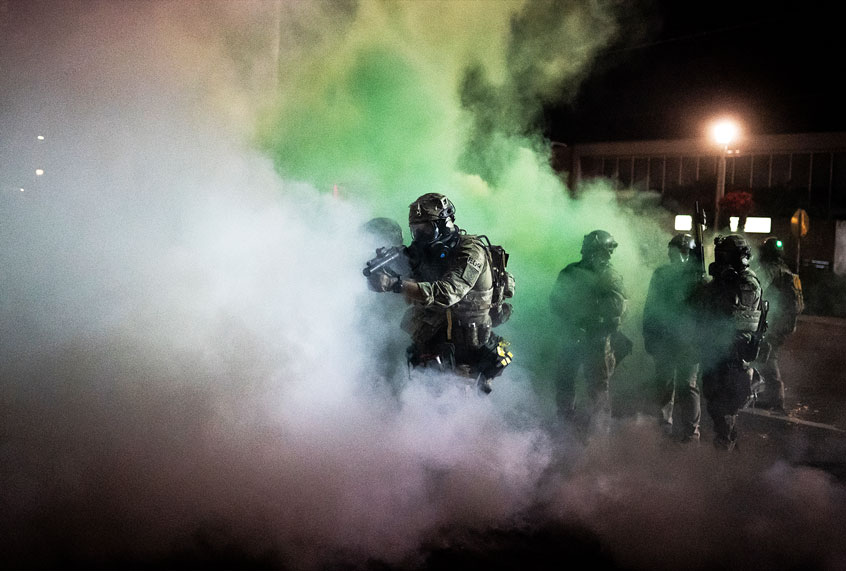Jacob Blake was doing what any responsive dad and neighbor does: stepping in to break up a fight before leaving with his children. But police in Kenosha, Wisconsin, shot Blake in the back seven times, with his three young sons watching from the car. Yet again, instead of meeting this moment with any empathy or understanding, Donald Trump sent federal law enforcement into Wisconsin in an effort to silence a community in mourning. Throughout this summer, our communities have risen up in defense of Black lives, only to be met with state violence from a militarized police force that has no interest in helping us.
The patterns are there if we look for them.
It goes like this: People around the country rise up to protest police brutality and injustice. Instead of listening and focusing on solutions aimed at the root causes of violence, the government consistently responds with additional violence and federal force. It’s as if to say: You may be strong, you may be loud, you may be a movement of the people, but we have more weapons.
This is a time to keep our memory sharp.
Remember: Following the heartbreaking 2014 murder of Mike Brown in Ferguson, Missouri, families and community members living in the area came out in the streets to protest police brutality. What ensued was the deployment of a police force resembling an occupying army. Sniper rifles, armored vehicles and tear gas were turned on Ferguson protesters, onlookers and the media. Journalists reporting on the protests were arrested.
Remember: Following the assassination of Dr. Martin Luther King Jr. in 1968, thousands of National Guard troops were deployed in the city of Baltimore for two weeks. Six people were killed and dozens more injured in this outbreak of state-sanctioned violence. In fact, that fall the U.S. Army published a then-classified plan called the “Garden Plot,” a detailed blueprint to deploy troops simultaneously to 25 American cities to quell protests against the Vietnam War and the military draft.
The patterns are there.
The oddest turn of phrase in American public discourse is probably “keep the peace,” when used to describe people who have access to lethal force, which is almost always used with impunity against those with access to none. But this has been normalized in the United States. In fact, this normalization is the result of several decades of policy that creates avenues for U.S. police to become further enmeshed with U.S. military forces.
After Sept. 11, 2001, in the name of safety and “homeland security,” billions and billions of tax dollars have been poured into an effort to militarize law enforcement in the U.S. The effect: We have built domestic police force that can turn on a dime to invade and occupy our towns and cities like an army, rather than to “protect and serve” our communities around the country.
This summer, the Trump administration deployed a variety of federal agents to Portland, including U.S. marshals and Customs and Border Protection officers, adding their names to this ignoble legacy of leaders who have used occupying military force against their own people. The violent exercise of using excessive force against peaceful demonstrators, alongside seemingly arbitrary detentions and arrests, is clearly intended to intimidate and silence. We know, because this playbook is not new and our memory is long.
If we don’t propose a clearly defined vision of what safety looks like, our demands run the risk of being co-opted in ways that don’t serve us. We can’t afford to let others define what we mean. In July, the Movement for Black Lives (M4BL) announced the development of the next phase of their work, the BREATHE Act, a new vision for community safety that invests proactively in protecting Black life. It calls for a divestment of federal dollars that have contributed to the militarization, surveillance, incarceration and impoverishment of Black communities.
A federal judge issued a temporary restraining order against the federal agents deployed in Portland. The order prohibits the federal agents from arresting, dispersing or using force against journalists and legal observers who are attending protests. This did not stop Attorney General Bill Barr from doubling down and announcing the launch of Operation Legend, an initiative that clearly echoes historical efforts to quell popular uprisings against state-sanctioned violence, and to obfuscate who is perpetrating violence and who is rising up to challenge it.
With troops having been called into Wisconsin to overpower rightful protest in the wake of Jacob Blake’s death, a similar cycle begins. But we know the patterns.
Ultimately, this is a moment to remind ourselves of what safe communities look like and feel like. Do you imagine that your community will feel safe if, at any point, federal officers can descend onto your streets, grab you up and claim it was all in the name of “keeping the peace?” For most of us, the answer is of course not. So, when the Trump administration and its allies appear on national television to assert that their actions are about safety, let’s reject that anemic and warped idea of safety and offer our own.
It’s time to create new patterns, new policies and new ways of keeping us safe, of keeping real peace.

